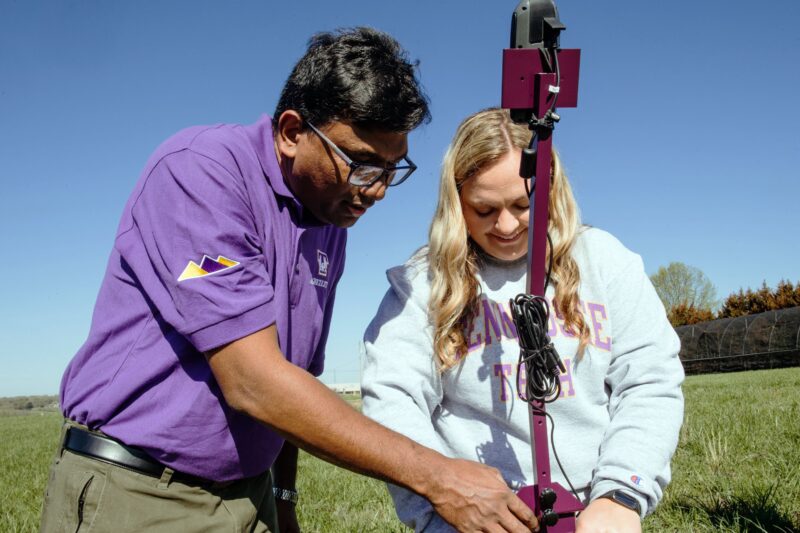Records information such as denseness of the soil and the chemical properties
Cookeville – A group of Tennessee Tech University agriculture students gather in a rolling field in the early morning sun at the university’s Shipley Farm in Cookeville. Instead of teaching inside the classroom, Abdul Momin, Ph.D., assistant professor in the School of Agriculture, is giving his class the chance to get hands-on experience using the technology that they are learning about in his course.

GPS – Assistant Professor Abdul Momin and Tech student Hailey Hill pictured at Tech’s Shipley Farm.
He is teaching about Global Positioning Systems (GPS) and Geographic Information Systems (GIS) and how tech-smart farmers are using these technologies to save time and money in their crop production.
“The United States has been called the ‘breadbasket’ of the world,” Momin said. “By the year 2050, U.S. growers will need to reach an impressive level of food production to continue to feed the nation efficiently and to help feed the growing world population. Food and agricultural production must increase by 70% for an additional 2.3 billion people. Thus, it is essential to introduce innovative data-driven and precision agriculture technologies to provide abundant and high-quality food.”
Out at Shipley Farm, students insert an instrument into the soil approximately every 10 feet. It records information such as denseness of the soil and the chemical properties at each spot. Once they have gone over the entire field, this information will be turned into a map that will provide a wealth of information for when the time comes to plant crops.
“Typically, in the past, growers made most decisions based on their intuition,” Momin explained. “It was difficult for growers to correlate production techniques and crop yields with land variability. Growers often recognize the in-field variability of their field; however, they had limited ability to manage that variability. As a result, growers have based management decisions on average conditions, hoping the inputs would be adequate for most of the field.”
Now, instead of treating all their land largely the same, farmers can use GPS and GIS to give each portion of land only the attention it needs – and nothing extra. For example, one portion of land may have more tightly packed soil than another area and need more effort in tilling. Likewise, one portion of land may need different nutrients than another. The informational maps save farmers time, money and effort when they can focus on giving each area of their farm the exact attention that it needs to produce the healthiest and most abundant crops possible.
While taking these classes, the students are also encouraged to take internships with local farms to get real on-the-job experience in working with these technologies. This partnership also benefits the local farms that have not adopted this type of technology yet. Some students also bring their new knowledge and skills back to their family farms and integrate the new technology there.
“I believe this class will help me in my future career by helping me learn how to collect data in the field and transfer it into QGIS an open-source GIS software and Microsoft Excel,” said Hailey Hill, a senior agriculture engineering major from Talbott, Tennessee.
Fellow student Chandler Fryar, a junior agriculture major from Ooltewah, Tennessee, says he plans to start his own land management business where he can use all of the technologies he is learning in Momin’s classes to help him make the best management decisions. Another fellow student, Chase Faudi, a junior agricultural engineering student from Soddy Daisy, Tennessee, plants to go into land surveying when he graduates.
“The future of agriculture depends on innovative solutions and next-generation problem solvers,” Momin said. “The rapidly growing populations and the persistent threats of climate change make research related to food production a top priority for governments around the world. The application of GPS and GIS improves farming production efficiency, reduces input costs, increases yield and protects the environment.”
Image by kjpargeter on Freepik









